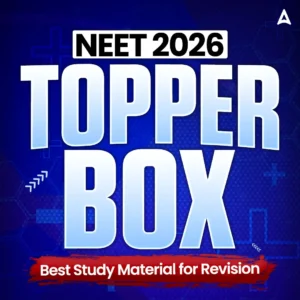The National Eligibility cum Entrance Test is conducted annually by the National Testing Agency across the nation with the objective to recruit students for admission into various medical courses. All the aspirants who are looking forward to appear for this national level examination must start preparing for the exam by studying chapters and topics mentioned in the NEET Syllabus 2026.
Physics is a major part of the NEET 2026 exam, therefore, all the aspirants must focus on the NEET Physics Syllabus 2026 by visiting the official website. In this article, we have shared the NEET Physics MCQs for Electrostatics Chapter so that all the aspirants can start preparing for the exam accordingly.
NEET Physics MCQs for Electrostatics Chapter
Electrostatics is one of the most fundamental and scoring chapters in NEET Physics. Every year, at least 2–3 questions are asked from this chapter, making it essential for aspirants to prepare thoroughly. Electrostatics deals with electric charges at rest, their interactions, and the fields and potentials they produce. Understanding its core concepts not only helps with direct NEET MCQs but also builds a strong foundation for future chapters like Current Electricity and Capacitance.
This article provides a comprehensive overview of Electrostatics for NEET aspirants, along with important MCQs with solutions to help you practice and master this topic.
Key Topics in Electrostatics for NEET
The NEET Electrostatics chapter covers fundamental physics concepts, including electric charge, electric field, and electric potential and capacitance. It explains the properties of charges, the forces between them, and the energy associated with their arrangement. The chapter also introduces dielectrics and polarization, with a significant focus on capacitors, which are crucial for the NEET exam due to their scoring potential and foundation-building nature for subsequent electricity concepts. Before attempting MCQs, aspirants must be familiar with the following subtopics:
- Electric Charge and Its Properties
- Types of charges: positive and negative
- Quantization and conservation of charge
- Charging by conduction, induction
- Coulomb’s Law
- Force between two point charges
- Vector form of Coulomb’s law
- Superposition principle
- Electric Field
- Electric field due to a point charge
- Field lines and their properties
- Electric field due to dipole, continuous charge distribution
- Electric Flux and Gauss’s Law
- Concept of electric flux
- Applications of Gauss’s law (sphere, cylinder, plane sheet)
- Electric Potential and Potential Energy
- Potential due to point charge
- Equipotential surfaces
- Work done in moving a charge
- Capacitance
- Capacitors and combination of capacitors
- Energy stored in capacitors
- Effect of dielectric medium
Importance of Solving NEET Physics MCQs for Electrostatics Chapter
All the aspirants of the NEET Exam must solve more and more NEET Physics MCQs for Electrostatics Chapter so that they are able to complete their preparations for the exam using them. By solving more and more NEET Physics MCQs for Electrostatics Chapter, aspirants will get several key benefits as listed below:
- Boosts Conceptual Clarity: MCQs test your understanding of fundamental laws and formulas.
- Improves Speed & Accuracy: Regular practice trains you to solve problems quickly under exam conditions.
- Covers Diverse Question Types: You get exposure to theory-based, numerical, and application-oriented questions.
- Reduces Exam Anxiety: Familiarity with question patterns builds confidence for the actual NEET exam.
- Strengthens Weak Areas: Analyzing mistakes in MCQ practice helps you focus on concepts you struggle with.
NEET Physics MCQs on Electrostatics Chapter
The aspirants who are looking forward to appear for the NEET Exam must start preparing for the exam by solving more and more Electrostatics MCQs as listed below:
Q1. The force between two charges +3 μC and −3 μC separated by 1 m in vacuum is:
(a) 9 N
(b) 27 N
(c) 81 N
(d) 0 N
Solution:
Correct Answer: (c) 81 N
Q2. The electric field intensity due to a uniformly charged infinite plane sheet does not depend on:
(a) Charge density
(b) Distance from the sheet
(c) Permittivity of the medium
(d) None of the above
Solution:
Electric field due to an infinite sheet:
It is independent of distance from the sheet.
Correct Answer: (b) Distance from the sheet
Q3. The work done in moving a 2 μC charge between two points having potential difference 10 V is:
(a) 20 μJ
(b) 5 μJ
(c) 2 μJ
(d) 10 μJ
Solution:
Correct Answer: (a) 20 μJ
Q4. A point charge q is placed at the center of a spherical Gaussian surface. The electric flux through the surface depends on:
(a) Radius of the sphere
(b) Charge enclosed
(c) Shape of the surface
(d) Area of the sphere
Solution:
From Gauss’s law:
It depends only on charge enclosed.
Correct Answer: (b) Charge enclosed
Q5. Two capacitors of capacitance 6 μF and 12 μF are connected in series across a 12 V battery. The potential difference across 12 μF capacitor is:
(a) 4 V
(b) 6 V
(c) 8 V
(d) 2 V
Solution:
Equivalent capacitance:
Charge stored:
Potential across 12 μF capacitor:
Correct Answer: (a) 4 V
Year-Wise NEET Physics MCQs for Electrostatics Chapter
In the table listed below, we have added the year-wise NEET Physics MCQs for the Electrostatics Chapter so that all the students can start preparing accordingly. Click on the links below:
| Year-Wise NEET Physics MCQs for Electrostatics Chapter | |
| Year | Links |
| 2014 | Click Here |
| 2015 | Click Here |
| 2016 | Click Here |
| 2017 | Click Here |
| 2018 | Click Here |
| NEET Physics Chapters | MCQ Link |
|---|---|
| Physics and Measurement | Click Here |
| Kinematics | Click Here |
| Laws of Motion | Click Here |
| Work, Energy, and Power | Click Here |
| Rotational Motion | Click Here |
| Gravitation | Click Here |
| Properties of Solids and Liquids | Click Here |
| Thermodynamics | Click Here |
| Kinetic Theory of Gases | Click Here |
| Oscillation and Waves | Click Here |
| Electrostatics | Click Here |
| Current Electricity | Click Here |
| Magnetic Effects of Current and Magnetism | Click Here |
| Electromagnetic Induction and Alternating Currents | Click Here |










 NEET Preparation Strategy 2026: Detailed...
NEET Preparation Strategy 2026: Detailed...
 Free NEET Sample Papers 2026 PDF | Downl...
Free NEET Sample Papers 2026 PDF | Downl...
 Salt Analysis NEET Notes, Check Importan...
Salt Analysis NEET Notes, Check Importan...








